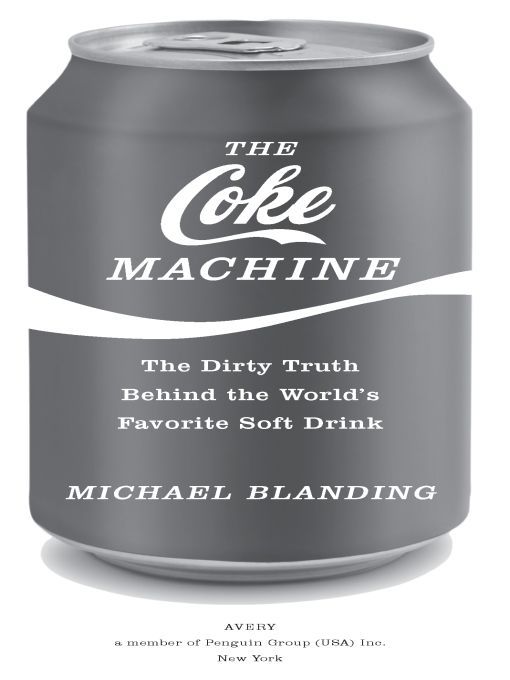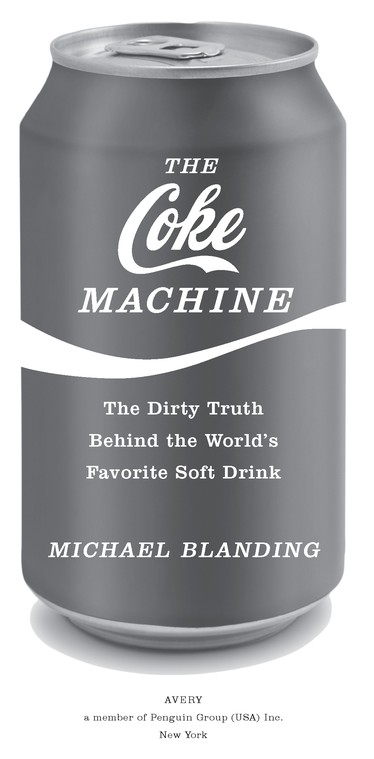The Coke Machine
Authors: Michael Blanding


Table of Contents


Published by the Penguin Group
Penguin Group (USA) Inc., 375 Hudson Street, New York, New York 10014, USA •
Penguin Group (Canada), 90 Eglinton Avenue East, Suite 700, Toronto, Ontario M4P 2Y3, Canada (a division of Pearson Penguin Canada Inc.) • Penguin Books Ltd, 80 Strand, London WC2R 0RL, England • Penguin Ireland, 25 St Stephen’s Green, Dublin 2, Ireland (a division of Penguin Books Ltd) • Penguin Group (Australia), 250 Camberwell Road, Camberwell, Victoria 3124, Australia (a division of Pearson Australia Group Pty Ltd) • Penguin Books India Pvt Ltd, 11 Community Centre, Panchsheel Park, New Delhi-110 017, India • Penguin Group (NZ), 67 Apollo Drive, Rosedale, North Shore 0632, New Zealand (a division of Pearson New Zealand Ltd) •
Penguin Books (South Africa) (Pty) Ltd, 24 Sturdee Avenue, Rosebank, Johannesburg 2196, South Africa
Penguin Books Ltd, Registered Offices: 80 Strand, London WC2R 0RL, England
All rights reserved. No part of this book may be reproduced, scanned, or distributed in any printed or electronic form without permission. Please do not participate in or encourage piracy of copyrighted materials in violation of the author’s rights.
Purchase only authorized editions. Published simultaneously in Canada
Most Avery books are available at special quantity discounts for bulk purchase for sales promotions, premiums, fund-raising, and educational needs. Special books or book excerpts also can be created to fit specific needs. For details, write Penguin Group (USA) Inc. Special Markets, 375 Hudson Street, New York, NY 10014.
Library of Congress Cataloging-in-Publication Data
Blanding, Michael.
The Coke machine : the dirty truth behind the world’s favorite soft drink / Michael Blanding.
p. cm.
Includes bibliographical references and index.
eISBN : 978-1-101-44340-8
1. Coca-Cola Company—History. 2. Soft drink industry.
3. Bottled water industry. 4. International business enterprises. I. Title.
HD9349.S634C
3. Bottled water industry. 4. International business enterprises. I. Title.
HD9349.S634C
338.7’66362—dc22
While the author has made every effort to provide accurate telephone numbers and Internet addresses at the time of publication, neither the publisher nor the author assumes any responsibility for errors, or for changes that occur after publication.
Further, the publisher does not have any control over and does not assume any responsibility for author or third-party websites or their content.
For Alex—for everything
Introduction
T
he Coca-Cola bottling plant in Carepa, Colombia, is an unlovely pile of brick on the outskirts of a sweltering Caribbean backwater. It sits past sad dogs blinking away flies on dirty streets, men loading yuccas and plantains into peddle carts, and gaudy open-roof
chivas
spewing diesel fumes as they idle by the roadside. Surrounding it, fields stretch to the horizon, studded with lonely palm and banana trees. The only consolation is a roadside Madonna on the edge of the gravel parking lot, a solitary benediction to bless the way of those leaving town.
he Coca-Cola bottling plant in Carepa, Colombia, is an unlovely pile of brick on the outskirts of a sweltering Caribbean backwater. It sits past sad dogs blinking away flies on dirty streets, men loading yuccas and plantains into peddle carts, and gaudy open-roof
chivas
spewing diesel fumes as they idle by the roadside. Surrounding it, fields stretch to the horizon, studded with lonely palm and banana trees. The only consolation is a roadside Madonna on the edge of the gravel parking lot, a solitary benediction to bless the way of those leaving town.
On the morning of December 5, 1996, two men pulled a motorbike into the gravel driveway. They circled the parking lot a few times before coming to a stop in front of the gate. Inside the battered chain-link fence was a courtyard piled with soda crates waiting to be loaded onto delivery trucks. On either side was a wall of heavy pink brick, painted with the Coke logo. And to the right, a small gatehouse set into the wall looked through metal slats at the parking lot.
The motorcycle’s passenger dismounted, while the driver sat with the engine idling. Walking up to the fence, he addressed the gatekeeper, a thin man with light brown skin, coffee-colored eyes, a mustache, and heavy eyebrows. That matched the description the visitor had been given, but he had to be sure.
“Are you Isidro Gil?” he asked.
Inside, the man hesitated slightly before replying. “Yeah. But why do you want to know?”
“We need to go inside and see a client.”
“Wait a minute,” replied Gil, who just then saw a delivery truck rumbling up from the yard. “Let me deal with this truck first, and then I’ll help you out.”
With nothing to do but his job, Gil unlocked the gate and pulled the chain-link fence toward either side to allow the truck to pass. Perhaps he suspected the danger he was in and simply resigned himself to his fate. More likely he somehow thought he would be spared from any potential violence by his position in the hierarchy of the bottlers’ union, by promises the plant management had given ensuring his safety, by the fact that it was nine in the morning in a public location with plenty of people milling around the plant.
In fact, this was not the first strange motorcycle that he had seen this morning. A half-hour earlier, another had pulled up to the small kiosk by the side of the road that served Coke to workers before and after their shifts. Gil had watched one of his coworkers point him out, and the cyclist nod before driving off. Gil was still worrying about the incident when the second motorcycle appeared.
In Colombia, a motorcycle isn’t just a motorcycle. It’s also the transport of choice for the paramilitary death squads that target guerrillas and anyone remotely associated with them on the other side of the country’s smoldering thirty-five-year-old civil war. In Medellín at the time, men were forbidden from carrying another man as a passenger, since it was so common for one to drive while the other pulled a trigger.
But Gil wasn’t the kind of person to back down from confrontation. Among his coworkers, the twenty-eight-year-old was a natural leader. Gregarious and charismatic, he’d organize fishing trips to the river and soccer and baseball tournaments on the weekends. He started out on the production line, but was reassigned to his current job at the front gate in 1994, just around the same time the paramilitaries started ominously appearing in the region.
Ostensibly, the death squads targeted the guerrillas who used the Caribbean location to import guns from Panama or tax drug shipments heading farther north. But the guerrillas were difficult targets, hiding in camps buried deep in the jungles. So soon the death squads turned their attentions to the civilians whom they suspected of supporting the guerrillas—a long list, including left-wing politicians, academics, health and human rights workers, teachers, and trade unionists.
The union at the Coke plant, SINALTRAINAL, was a natural target. Two of its leaders had already been killed by the time Isidro Gil was named secretary-general and put in charge of renegotiating the workers’ contract with the bottling company. On November 18, 1996, the union submitted its final proposal for a new contract, demanding increased pay and benefits, along with protection from firing and new security measures to keep union leadership safe from violence.
The Coke plant’s local managers and its Florida-based owners had until December 5 to respond to the collective bargaining proposal. As he stood at the gate that morning, Gil was mentally preparing for the meeting that day, not knowing it would never take place. As he opened the gate to let out the delivery truck, he stepped back behind the gatehouse. The truck rumbled past, its bright red Coke logo shining in the morning light. Before Gil could push the metal frame closed, the visitor walked right through the gate behind it. Pulling out a .38 Special, he raised it to Gil’s face and shot him between the eyes.
On the face of it, this was just one more casualty in a Third World country’s long and bloody civil war, a war that has claimed tens of thousands of lives—including more than 2,500 union members in the last twenty years. For the national leaders of SINALTRAINAL, however, this was something more: part of a coordinated campaign to stamp out union activism at the bottling plant, orchestrated by the bottler and the Coca-Cola Company itself. Before it was over, eight union leaders would be killed in Carepa and the union driven to extinction. At best, they charged, Coke stood by and let it happen. At worst, they said, company managers directed the violence through regular coordinated meetings with paramilitaries inside the plant.
It’s a shocking allegation to level at the company that has presented through its advertising one of the most compelling visions of international peace and harmony the world has ever seen. And yet it’s not the only charge that has been leveled in recent years against the Coca-Cola Company, which stands accused of decimating water supplies of villagers in India and Mexico, busting up unions in Turkey and Guatemala, making kids fat throughout the United States and Europe, and hoodwinking consumers into swallowing glorified tap water marketed under its bottled water brand Dasani.
Perhaps it’s not too much of a surprise to find the Coca-Cola Company on the stand for these injustices. In this era of cynicism, it’s standard practice to believe corporations from Halliburton to ExxonMobil capable of every form of evil, trained by the profit drive of capitalism to turn a blind eye to the worst consequences of their actions. The Coca-Cola Company, however, represents a special case—at once the quintessential example of a giant American multinational corporation and a beloved pop culture symbol that has spent billions of dollars to present an image of wholesomeness and harmony that has made it cherished by millions of people around the world. Finding the Coca-Cola Company accused of murder is like finding out Santa Claus is accused of being a pedophile.
So how is it
that a company that, in its own words, “exists to refresh and benefit everyone it touches” now stands accused of drought, disease, exploitation, and murder? To truly understand that contradiction, it’s necessary to go back to Coca-Cola’s origins as a cocaine-laced “nerve tonic” in the turn-of-the-century American South. It’s there that the seeds of its inexorable drive to growth were planted, along with the decisions that have allowed it to disavow responsibility for its bottlers around the globe. That’s the essence of Coca-Cola—what one of its legendary executives once called “the essence of capitalism.”
that a company that, in its own words, “exists to refresh and benefit everyone it touches” now stands accused of drought, disease, exploitation, and murder? To truly understand that contradiction, it’s necessary to go back to Coca-Cola’s origins as a cocaine-laced “nerve tonic” in the turn-of-the-century American South. It’s there that the seeds of its inexorable drive to growth were planted, along with the decisions that have allowed it to disavow responsibility for its bottlers around the globe. That’s the essence of Coca-Cola—what one of its legendary executives once called “the essence of capitalism.”
Other books
Asylum City by Liad Shoham
Philida by André Brink
A Rose for the Crown by Anne Easter Smith
Cherish the Land by Ariel Tachna
A World Apart by Peter McAra
Dirty Deeds Done Cheap by Peter Mercer
Manhood: How to Be a Better Man-or Just Live with One by Terry Crews
Partitions: A Novel by Majmudar, Amit
Sabotage by Karen King
Stepbrother Reunited (Billionaire Stepbrother BBW Romance) by Harper Bloom